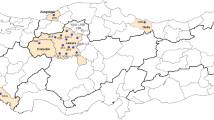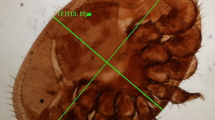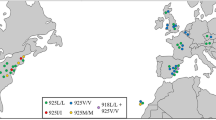Abstract
The ectoparasitic honey bee mite Varroa destructor Anderson & Trueman (Acari: Varroidae) is one of the major concerns for worldwide beekeeping. The use of synthetic pyrethroids for controlling the mite was among the most popular treatments until resistance evolved in the mid 1990’s. In Iran, beekeepers are dealing with the parasite and they also used pyrethroids for controlling the mite for a long time. After the evolution of resistance to pyrethroids, they based mite control mostly on treatments with amitraz, organic acids and several management practices. Here we conducted a comprehensive characterization of V. destructor populations parasitizing Apis mellifera in Iran. We determined the genetic variability of mites collected from 28 localities distributed throughout the country. The haplotype of V. destructor was determined by PCR-RFLP, analyzing a fragment of the mitochondrial cox1 gene. It was found that only the Korean haplotype was present in samples from all localities. DNA fragments from cox1, atp6, cox3 and cytb mitochondrial genes were sequenced and the results showed that all samples were identical to the K1-1 or the K1-2 V. destructor haplotypes. Moreover, as it has been reported that resistance to pyrethroids in V. destructor is associated with mutations at position 925 of the voltage-gated sodium channel, a TaqMan®-based allelic discrimination assay was conducted to genotype the mites collected. The results showed that all the mites tested were homozygous for the wild-type allele and, therefore, susceptible to treatment with pyrethroids.




Similar content being viewed by others
References
Alissandrakis E, Ilias A, Tsagkarakou A (2017) Pyrethroid target site resistance in Greek populations of the honey bee parasite Varroa destructor (Acari: Varroidae). J Apic Res 56:625–630
Anderson DL, Fuchs S (1998) Two genetically distinct populations of Varroa jacobsoni with contrasting reproductive abilities on Apis mellifera. J Apic Res 37:69–78
Anderson DL, Trueman JWH (2000) Varroa jacobsoni (Acari: Varroidae) is more than one species. Exp Appl Acarol 24:165–189
Boecking O, Genersch E (2008) Varroosis—the ongoing crisis in bee keeping. J Verbr Lebensm 3:221–228
Bokaie S, Sharifi L, Mehrabadi M (2014) Prevalence and epizootical aspects of varroasis in Golestan province, Northern Iran. J Arthropod Borne Dis 8:102–107
Denholm I, Rowland MW (1992) Tactics for managing pesticide resistance in arthropods: theory and practice. Annu Rev Entomol 37:91–112
Dong K, Du Y, Rinkevich F, Nomura Y, Xu P, Wang L, Silver K, Zhorov BS (2014) Molecular biology of insect sodium channels and pyrethroid resistance. Insect Biochem Mol Biol 50:1–17
Evans JD, Lopez DL (2002) Complete mitochondrial DNA sequence of the important honey bee pest, Varroa destructor (Acari: Varroidae). Exp Appl Acarol 27:69–79
Gajić B, Radulović Z, Stevanović J, Kulisić Z, Vucicević M, Simeunović P, Stanimirović Z (2013) Variability of the honeybee mite Varroa destructor in Serbia, based on mtDNA analysis. Exp Appl Acarol 61:97–105
Gajić B, Stevanović J, Radulović Ž, Kulišić Z, Vejnović B, Glavinić U, Stanimirović Z (2016) Haplotype identification and detection of mitochondrial DNA heteroplasmy in Varroa destructor mites using ARMS and PCR-RFLP methods. Exp Appl Acarol 70:287–297
Genersch E, von der Ohe W, Kaatz H, Schroeder A, Otten C, Büchler R, Berg S, Ritter W, Mühlen W, Gisder S, Meixner M, Liebig G, Rosenkranz P (2010) The German bee monitoring project: a long term study to understand periodically high winter losses of honey bee colonies. Apidologie 41:332–352
González-Cabrera J, Davis TGE, Field LM, Kennedy PJ, Williamson MS (2013) An amino acid substitution (L925 V) associated with resistance to pyrethroids in Varroa destructor. PLoS ONE 8(12):e82941
González-Cabrera J, Rodríguez-Vargas S, Davies TG, Field LM, Schmehl D, Ellis JD, Krieger K, Williamson MS (2016) Novel mutations in the voltage-gated sodium channel of pyrethroid-resistant Varroa destructor populations from the Southeastern USA. PLoS ONE 11(5):e0155332
Guzmán-Novoa E, Eccles L, Calvete Y, McGovan J, Kelly PG, Correa-Benítez A (2010) Varroa destructor is the main culprit for the death and reduced populations of overwintered honey bee (Apis mellifera) colonies in Ontario, Canada. Apidologie 41:443–450
Hajializadeh Z, Asadi M, Kavousi H (2018) First report of Varroa genotype in western Asia based on genotype identification of Iranian Varroa destructor populations (Mesostigmata: Varroidae) using RAPD marker. Syst Appl Acarol 23:199–205
Hubert J, Nesvorna M, Kamler M, Kopecky J, Tyl J, Titera D, Stara J (2014) Point mutations in the sodium channel gene conferring tau-fluvalinate resistance in Varroa destructor. Pest Manag Sci 70:889–894
Kearse M, Moir R, Wilson A, Stones-Havas S, Cheung M, Sturrock S, Buxton S, Cooper A, Markowitz S, Duran C, Thierer T, Ashton B, Mentjies P, Drummond A (2012) Geneious basic: an integrated and extendable desktop software platform for the organization and analysis of sequence data. Bioinformatics 28:1647–1649
Kelomey AE, Paraiso A, Sina H, Legout H, Garnery L, Baba-Moussa L (2017) Genetic characterization of the honeybee ectoparasitic mite Varroa destructor from Benin (West Africa) using mitochondrial and microsatellite markers. Exp Appl Acarol 72:61–67
Kliot A, Ghanim M (2012) Fitness costs associated with insecticide resistance. Pest Manag Sci 68:1431–1437
Martin S, Hogarth A, van Breda J, Perrett J (1998) A scientific note on Varroa jacobsoni Oudemans and the collapse of Apis mellifera L. colonies in the United Kingdom. Apidologie 29:369–370
Milani N, Della Vedova G (2002) Decline in the proportion of mites resistant to fluvalinate in a population of Varroa destructor not treated with pyrethroids. Apidologie 33:417–422
Muñoz I, Garrido-Bailón E, Martín-Hernández R, Meana A, Higes M, De la Rúa P (2008) Genetic profile of Varroa destructor infesting Apis mellifera iberiensis colonies. J Apic Res Bee World 47:310–313
Navajas M, Solignac M, Le Conte Y, Cros-Arteil S, Cornuet JM (2002) The complete sequence of the mitochondrial genome of the honey-bee ectoparasite Varroa destructor (Acari: Mesostigmata). Mol Biol Evol 19:2313–2317
Navajas M, Anderson DL, de Guzman LI, Huang ZY, Clement J, Zhou T, Le Conte Y (2010) New Asian types of Varroa destructor: a potential new threat for world apiculture. Apidologie 41:181–193
Rosenkranz P, Aumeier P, Ziegelmann B (2010) Biology and control of Varroa destructor. J Invertebr Pathol 103:S96–S119
Shahrouzi R (2009) The efficacy of Apivar® and Bayvarol® and CheckMite + ® in the control of Varroa destructor in Iran. http://www.apiservices.biz/en/articles/. Accessed 12 Sept 2018
Shahrouzi R (2012) Three decades of living with Varroa in Iran. http://www.apiservices.biz/en/articles/. Accessed 12 Sept 2018
Solignac M, Cornuet JM, Vautrin D, Le Conte Y, Anderson D, Evans J, Cros-Arteil S, Navajas M (2005) The invasive Korea and Japan types of Varroa destructor, ectoparasitic mites of the Western honey bee (Apis mellifera), are two partly isolated clones. Proc R Soc Lond B Biol Sci 272:411–419
Acknowledgements
Joel González-Cabrera was supported by the Spanish Ministry of Economy and Competitiveness, Ramón y Cajal Program (RYC-2013-13834). The work at the Universitat de València was funded by a Grant from the Spanish Ministry of Economy and Competitiveness (CGL2015-65025-R, MINECO/FEDER, UE) and by Bayer Animal Health GmbH, Leverkusen, Germany. This research was partly supported by a Grant (No. 7110018/6/24) from the University of Tehran. This research was also supported by the Department of Plant Protection, University of Tehran, Karaj, Iran. The authors express their gratitude to Dr. Alexis Beaurepaire (France) for the valuable suggestion and for critically reading the map sampling. We are also grateful to Dr. Jamasb Nozari (University of Tehran, Iran) for his assistance in selecting bee colonies in Iran. Finally, we thank the local beekeepers for the provision of bees and mites.
Author information
Authors and Affiliations
Corresponding authors
Electronic supplementary material
Below is the link to the electronic supplementary material.
Rights and permissions
About this article
Cite this article
Farjamfar, M., Saboori, A., González-Cabrera, J. et al. Genetic variability and pyrethroid susceptibility of the parasitic honey bee mite Varroa destructor (Acari: Varroidae) in Iran. Exp Appl Acarol 76, 139–148 (2018). https://doi.org/10.1007/s10493-018-0296-1
Received:
Accepted:
Published:
Issue Date:
DOI: https://doi.org/10.1007/s10493-018-0296-1




